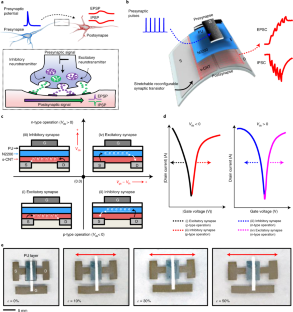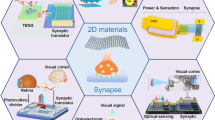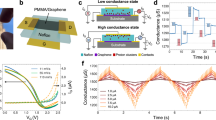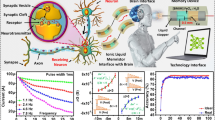Abstract
Neurons of the ventral tegmental area of the brain contain single axon terminals that release excitatory and inhibitory neurotransmitters, creating reconfigurable synaptic behaviour. Artificial synaptic transistors that exhibit similar excitatory and inhibitory behaviour—and hence synaptic function reconfiguration—could provide diverse functionality and efficient computing in various applications. However, some of these applications, such as soft robotics and wearable electronics, require synaptic devices that are mechanically soft and deformable. Here we report an elastic and reconfigurable synaptic transistor that exhibits inhibitory and excitatory characteristics even under mechanical strain. The synaptic device uses a top-gated configuration and is made using a stretchable bilayer semiconductor and an encapsulating elastomer as the gate dielectric. The device exhibits memory characteristics when operating with a presynaptic pulse of only 80 mV, resulting in a low specific energy consumption. When applied to a model artificial neural network for dual-directional image recognition of the Modified National Institute of Standards and Technology dataset, a recognition accuracy of over 90% is achieved even when the transistors are stretched by 50%.
This is a preview of subscription content, access via your institution
Access options
Access Nature and 54 other Nature Portfolio journals
Get Nature+, our best-value online-access subscription
$29.99 / 30 days
cancel any time
Subscribe to this journal
Receive 12 digital issues and online access to articles
$119.00 per year
only $9.92 per issue
Buy this article
- Purchase on Springer Link
- Instant access to full article PDF
Prices may be subject to local taxes which are calculated during checkout






Similar content being viewed by others
Data availability
The data that support the findings of this study or additional data related to this paper are available from the corresponding author upon request.
References
Root, D. H. et al. Single rodent mesohabenular axons release glutamate and GABA. Nat. Neurosci. 17, 1543–1551 (2014).
Thuruthel, T. G., Shih, B., Laschi, C. & Tolley, M. T. Soft robot perception using embedded soft sensors and recurrent neural networks. Sci. Robot. 4, eaav1488 (2019).
Moin, A. et al. A wearable biosensing system with in-sensor adaptive machine learning for hand gesture recognition. Nat. Electron. 4, 54–63 (2021).
Yao, H. et al. Near–hysteresis-free soft tactile electronic skins for wearables and reliable machine learning. Proc. Natl Acad. Sci. USA 117, 25352–25359 (2020).
Lee, Y. et al. Stretchable organic optoelectronic sensorimotor synapse. Sci. Adv. 4, eaat7387 (2018).
Shim, H. et al. Fully rubbery synaptic transistors made out of all-organic materials for elastic neurological electronic skin. Nano Res. 15, 758–764 (2021).
Molina-Lopez, F. et al. Inkjet-printed stretchable and low voltage synaptic transistor array. Nat. Commun. 10, 2676 (2019).
Shim, H. et al. Stretchable elastic synaptic transistors for neurologically integrated soft engineering systems. Sci. Adv. 5, eaax4961 (2019).
Na, Y. & Kim, F. S. Nanodroplet-embedded semiconducting polymer layers for electrochemically stable and high-conductance organic electrolyte-gated transistors. Chem. Mater. 31, 4759–4768 (2019).
Chortos, A. et al. Highly stretchable transistors using a microcracked organic semiconductor. Adv. Mater. 26, 4253–4259 (2014).
Zhu, L. Q., Wan, C. J., Guo, L. Q., Shi, Y. & Wan, Q. Artificial synapse network on inorganic proton conductor for neuromorphic systems. Nat. Commun. 5, 3158 (2014).
Liu, Y. H., Zhu, L. Q., Feng, P., Shi, Y. & Wan, Q. Freestanding artificial synapses based on laterally proton‐coupled transistors on chitosan membranes. Adv. Mater. 27, 5599–5604 (2015).
Xu, W., Min, S.-Y., Hwang, H. & Lee, T.-W. Organic core-sheath nanowire artificial synapses with femtojoule energy consumption. Sci. Adv. 2, e1501326 (2016).
Uchida, N. Bilingual neurons release glutamate and GABA. Nat. Neurosci. 17, 1432 (2014).
Choi, J. et al. Importance of critical molecular weight of semicrystalline n-type polymers for mechanically robust, efficient electroactive thin films. Chem. Mater. 31, 3163–3173 (2019).
Haftbaradaran, H. & Gao, H. Ratcheting of silicon island electrodes on substrate due to cyclic intercalation. Appl. Phys. Lett. 100, 121907 (2012).
Wu, X., Chu, Y., Liu, R., Katz, H. E. & Huang, J. Pursuing polymer dielectric interfacial effect in organic transistors for photosensing performance optimization. Adv. Sci. 4, 1700442 (2017).
Quinn, J. T., Zhu, J., Li, X., Wang, J. & Li, Y. Recent progress in the development of n-type organic semiconductors for organic field effect transistors. J. Mater. Chem. C 5, 8654–8681 (2017).
Ohno, T. et al. Short-term plasticity and long-term potentiation mimicked in single inorganic synapses. Nat. Mater. 10, 591–595 (2011).
Ji, X. et al. Mimicking associative learning using an ion-trapping non-volatile synaptic organic electrochemical transistor. Nat. Commun. 12, 2480 (2021).
Kim, H., Park, J., Kwon, M.-W., Lee, J.-H. & Park, B.-G. Silicon-based floating-body synaptic transistor with frequency-dependent short-and long-term memories. IEEE Electron Device Lett. 37, 249–252 (2016).
Yu, E., Cho, S., Roy, K. & Park, B.-G. A quantum-well charge-trap synaptic transistor with highly linear weight tunability. IEEE J. Electron Devices Soc. 8, 834–840 (2020).
Kim, D. et al. PZT ferroelectric synapse TFT with multi-level of conductance state for neuromorphic applications. IEEE Access 9, 140975–140982 (2021).
Liang, J. et al. Intrinsically stretchable and transparent thin-film transistors based on printable silver nanowires, carbon nanotubes and an elastomeric dielectric. Nat. Commun. 6, 7647 (2015).
Jin, S. H. et al. Sources of hysteresis in carbon nanotube field‐effect transistors and their elimination via methylsiloxane encapsulants and optimized growth procedures. Adv. Funct. Mater. 22, 2276–2284 (2012).
Tian, H. et al. A novel artificial synapse with dual modes using bilayer graphene as the bottom electrode. Nanoscale 9, 9275–9283 (2017).
Tamas, G., Buhl, E. & Somogyi, P. Fast IPSPs elicited via multiple synaptic release sites by different types of GABAergic neurone in the cat visual cortex. J. Physiol. 500, 715–738 (1997).
Ali, A. B. & Thomson, A. M. Synaptic α5 subunit–containing GABAA receptors mediate IPSPs elicited by dendrite-preferring cells in rat neocortex. Cereb. Cortex 18, 1260–1271 (2007).
Galarreta, M. & Hestrin, S. Electrical and chemical synapses among parvalbumin fast-spiking GABAergic interneurons in adult mouse neocortex. Proc. Natl Acad. Sci. USA 99, 12438–12443 (2002).
Yang, C. S. et al. All‐solid‐state synaptic transistor with ultralow conductance for neuromorphic computing. Adv. Funct. Mater. 28, 1804170 (2018).
Fu, Y. et al. Flexible neuromorphic architectures based on self-supported multiterminal organic transistors. ACS Appl. Mater. Interfaces 10, 26443–26450 (2018).
Kong, L.-a et al. Long-term synaptic plasticity simulated in ionic liquid/polymer hybrid electrolyte gated organic transistors. Org. Electron. 47, 126–132 (2017).
Wang, H. et al. A ferroelectric/electrochemical modulated organic synapse for ultraflexible, artificial visual‐perception system. Adv. Mater. 30, 1803961 (2018).
Dai, S. et al. Wood-derived nanopaper dielectrics for organic synaptic transistors. ACS Appl. Mater. Interfaces 10, 39983–39991 (2018).
Desbief, S. et al. Low voltage and time constant organic synapse-transistor. Org. Electron. 21, 47–53 (2015).
Choi, S. et al. SiGe epitaxial memory for neuromorphic computing with reproducible high performance based on engineered dislocations. Nat. Mater. 17, 335–340 (2018).
Wang, C.-Y. et al. Gate-tunable van der Waals heterostructure for reconfigurable neural network vision sensor. Sci. Adv. 6, eaba6173 (2020).
Wang, Y. et al. Modulation of binary neuroplasticity in a heterojunction-based ambipolar transistor. ACS Appl. Mater. Interfaces 12, 15370–15379 (2020).
van de Burgt, Y. et al. A non-volatile organic electrochemical device as a low-voltage artificial synapse for neuromorphic computing. Nat. Mater. 16, 414–418 (2017).
Fuller, E. J. et al. Li‐ion synaptic transistor for low power analog computing. Adv. Mater. 29, 1604310 (2017).
Seo, D.-G. et al. Versatile neuromorphic electronics by modulating synaptic decay of single organic synaptic transistor: from artificial neural networks to neuro-prosthetics. Nano Energy 65, 104035 (2019).
Lv, Z. et al. Mimicking neuroplasticity in a hybrid biopolymer transistor by dual modes modulation. Adv. Funct. Mater. 29, 1902374 (2019).
Pan, C. et al. Reconfigurable logic and neuromorphic circuits based on electrically tunable two-dimensional homojunctions. Nat. Electron. 3, 383–390 (2020).
Gaillardon, P.-E., Tang, X., Kim, G. & De Micheli, G. A novel FPGA architecture based on ultrafine grain reconfigurable logic cells. IEEE Trans. Very Large Scale Integr. (VLSI) Syst. 23, 2187–2197 (2014).
Qiao, N. et al. A reconfigurable on-line learning spiking neuromorphic processor comprising 256 neurons and 128K synapses. Front. Neurosci. 9, 141 (2015).
Covi, E. et al. Adaptive extreme edge computing for wearable devices. Front. Neurosci. 15, 611300 (2021).
Ham, S. et al. One-dimensional organic artificial multi-synapses enabling electronic textile neural network for wearable neuromorphic applications. Sci. Adv. 6, eaba1178 (2020).
John, R. A. et al. Self healable neuromorphic memtransistor elements for decentralized sensory signal processing in robotics. Nat. Commun. 11, 4030 (2020).
Fu, T. et al. Self-sustained green neuromorphic interfaces. Nat. Commun. 12, 3351 (2021).
Keene, S. T. et al. A biohybrid synapse with neurotransmitter-mediated plasticity. Nat. Mater. 19, 969–973 (2020).
Acknowledgements
C.Y. would like to acknowledge financial support from the Office of Naval Research grant (N00014-18-1-2338) under the Young Investigator Program, as well as the National Science Foundation grants of CAREER (1554499), EFRI (1935291) and CPS (1931893 and 2227062). T.J.M. and A.F. acknowledge support from the Air Force Office of Scientific Research grant (FA9550-18-1-0320 and FA9550-22-1-0423) and the Northwestern University MRSEC grant National Science Foundation DMR (1720139).
Author information
Authors and Affiliations
Contributions
H.S. and C.Y. conceived and designed the research. H.S., S.P. and Y.Z. performed the experiments. H.S. and C.Y. analysed the data. H.S. and F.E. performed the simulation work. B.W., Z.C., T.J.M. and A.F. provided the materials and advised on the experiment. H.S. and C.Y. wrote the manuscript. All the authors revised the manuscript.
Corresponding author
Ethics declarations
Competing interests
The authors declare no competing interests.
Peer review
Peer review information
Nature Electronics thanks Huipeng Chen, Zheng Yan and the other, anonymous, reviewer(s) for their contribution to the peer review of this work.
Additional information
Publisher’s note Springer Nature remains neutral with regard to jurisdictional claims in published maps and institutional affiliations.
Supplementary information
Supplementary Information
Supplementary Note 1 and Figs. 1–22.
Rights and permissions
Springer Nature or its licensor holds exclusive rights to this article under a publishing agreement with the author(s) or other rightsholder(s); author self-archiving of the accepted manuscript version of this article is solely governed by the terms of such publishing agreement and applicable law.
About this article
Cite this article
Shim, H., Ershad, F., Patel, S. et al. An elastic and reconfigurable synaptic transistor based on a stretchable bilayer semiconductor. Nat Electron 5, 660–671 (2022). https://doi.org/10.1038/s41928-022-00836-5
Received:
Accepted:
Published:
Issue Date:
DOI: https://doi.org/10.1038/s41928-022-00836-5
This article is cited by
-
Bridging length scales in organic mixed ionic–electronic conductors through internal strain and mesoscale dynamics
Nature Materials (2024)
-
Strain-insensitive viscoelastic perovskite film for intrinsically stretchable neuromorphic vision-adaptive transistors
Nature Communications (2024)
-
Motion artefact management for soft bioelectronics
Nature Reviews Bioengineering (2024)
-
Artificial morality basic device: transistor for mimicking morality logics
Science China Materials (2024)
-
Flexible DPPT-TT/PEO Fiber-Exploiting Electro-optical Synaptic Transistor for Artificial Withdrawal Reflex Arc
Advanced Fiber Materials (2024)



